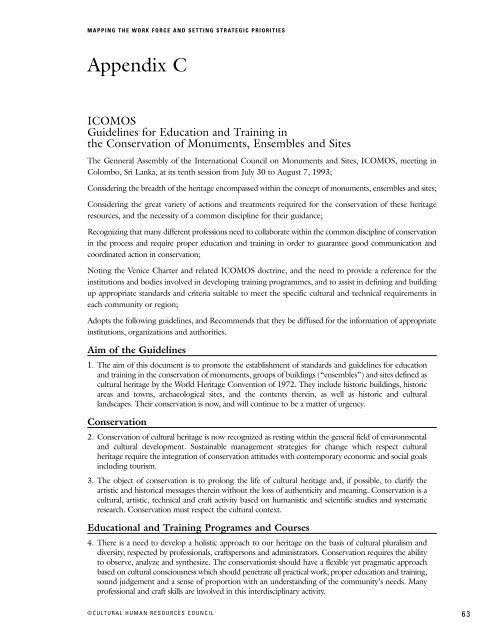Human Resources in Canada's Built Heritage Sector: Mapping the ...
Human Resources in Canada's Built Heritage Sector: Mapping the ...
Human Resources in Canada's Built Heritage Sector: Mapping the ...
- No tags were found...
Create successful ePaper yourself
Turn your PDF publications into a flip-book with our unique Google optimized e-Paper software.
MAPPING THE WORK FORCE AND SETTING STRATEGIC PRIORITIESAppendix CICOMOSGuidel<strong>in</strong>es for Education and Tra<strong>in</strong><strong>in</strong>g <strong>in</strong><strong>the</strong> Conservation of Monuments, Ensembles and SitesThe Genneral Assembly of <strong>the</strong> International Council on Monuments and Sites, ICOMOS, meet<strong>in</strong>g <strong>in</strong>Colombo, Sri Lanka, at its tenth session from July 30 to August 7, 1993;Consider<strong>in</strong>g <strong>the</strong> breadth of <strong>the</strong> heritage encompassed with<strong>in</strong> <strong>the</strong> concept of monuments, ensembles and sites;Consider<strong>in</strong>g <strong>the</strong> great variety of actions and treatments required for <strong>the</strong> conservation of <strong>the</strong>se heritageresources, and <strong>the</strong> necessity of a common discipl<strong>in</strong>e for <strong>the</strong>ir guidance;Recogniz<strong>in</strong>g that many different professions need to collaborate with<strong>in</strong> <strong>the</strong> common discipl<strong>in</strong>e of conservation<strong>in</strong> <strong>the</strong> process and require proper education and tra<strong>in</strong><strong>in</strong>g <strong>in</strong> order to guarantee good communication andcoord<strong>in</strong>ated action <strong>in</strong> conservation;Not<strong>in</strong>g <strong>the</strong> Venice Charter and related ICOMOS doctr<strong>in</strong>e, and <strong>the</strong> need to provide a reference for <strong>the</strong><strong>in</strong>stitutions and bodies <strong>in</strong>volved <strong>in</strong> develop<strong>in</strong>g tra<strong>in</strong><strong>in</strong>g programmes, and to assist <strong>in</strong> def<strong>in</strong><strong>in</strong>g and build<strong>in</strong>gup appropriate standards and criteria suitable to meet <strong>the</strong> specific cultural and technical requirements <strong>in</strong>each community or region;Adopts <strong>the</strong> follow<strong>in</strong>g guidel<strong>in</strong>es, and Recommends that <strong>the</strong>y be diffused for <strong>the</strong> <strong>in</strong>formation of appropriate<strong>in</strong>stitutions, organizations and authorities.Aim of <strong>the</strong> Guidel<strong>in</strong>es1. The aim of this document is to promote <strong>the</strong> establishment of standards and guidel<strong>in</strong>es for educationand tra<strong>in</strong><strong>in</strong>g <strong>in</strong> <strong>the</strong> conservation of monuments, groups of build<strong>in</strong>gs (“ensembles”) and sites def<strong>in</strong>ed ascultural heritage by <strong>the</strong> World <strong>Heritage</strong> Convention of 1972. They <strong>in</strong>clude historic build<strong>in</strong>gs, historicareas and towns, archaeological sites, and <strong>the</strong> contents <strong>the</strong>re<strong>in</strong>, as well as historic and culturallandscapes. Their conservation is now, and will cont<strong>in</strong>ue to be a matter of urgency.Conservation2. Conservation of cultural heritage is now recognized as rest<strong>in</strong>g with<strong>in</strong> <strong>the</strong> general field of environmentaland cultural development. Susta<strong>in</strong>able management strategies for change which respect culturalheritage require <strong>the</strong> <strong>in</strong>tegration of conservation attitudes with contemporary economic and social goals<strong>in</strong>clud<strong>in</strong>g tourism.3. The object of conservation is to prolong <strong>the</strong> life of cultural heritage and, if possible, to clarify <strong>the</strong>artistic and historical messages <strong>the</strong>re<strong>in</strong> without <strong>the</strong> loss of au<strong>the</strong>nticity and mean<strong>in</strong>g. Conservation is acultural, artistic, technical and craft activity based on humanistic and scientific studies and systematicresearch. Conservation must respect <strong>the</strong> cultural context.Educational and Tra<strong>in</strong><strong>in</strong>g Programes and Courses4. There is a need to develop a holistic approach to our heritage on <strong>the</strong> basis of cultural pluralism anddiversity, respected by professionals, craftspersons and adm<strong>in</strong>istrators. Conservation requires <strong>the</strong> abilityto observe, analyze and syn<strong>the</strong>size. The conservationist should have a flexible yet pragmatic approachbased on cultural consciousness which should penetrate all practical work, proper education and tra<strong>in</strong><strong>in</strong>g,sound judgement and a sense of proportion with an understand<strong>in</strong>g of <strong>the</strong> community’s needs. Manyprofessional and craft skills are <strong>in</strong>volved <strong>in</strong> this <strong>in</strong>terdiscipl<strong>in</strong>ary activity.©CULTURAL HUMAN RESOURCES COUNCIL63










